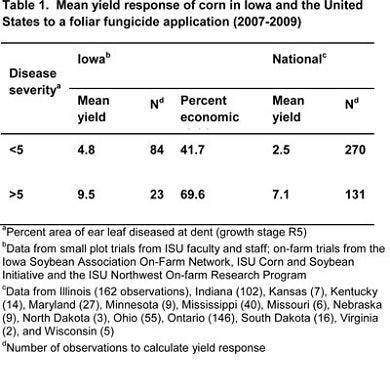
It never ceases to amaze people just how quickly corn grows. It does not seem that long ago that the corn was knee-high and now crops are 12 feet tall. Across the state, crops are flowering and pollination is underway. With tassels, comes the question: Should I spray a foliar fungicide?

University and industry data continue to report mean yield responses due to a fungicide application that vary from 4 bushel to as much as 15 bushels per acre. With grain prices as high as they are, it may appear to be worth risk to spray, but fungicide decisions should be based on more than just the price of grain, say Iowa State University Extension plant disease specialists Alison Robertson and Daren Mueller.
Four years of fungicide trials in Iowa and across the Corn Belt at numerous universities has clearly shown that yield responses are greater when disease is present in the field (see table 1). The data in the table shows the disease severity at R5 (dent) stage of corn, and the mean yield response that occurred when disease severity on the ear leaf was low (less than 5%) and when more than 5% of the ear leaf was diseased.
How much disease should be present at tasseling to justify applying fungicide?
But the key question is how much disease should be present at tasseling? "Good question and one we are working on," says ISU's Alison Robertson. Fungicide trials to establish thresholds for applying a fungicide are in progress in Iowa, Illinois, Wisconsin and Ohio. This work is being funded by a grant from the USDA RAMP (Risk Avoidance and Mitigation Program) program.
For now though, the threshold remains that you should consider a fungicide application if fungal disease is present on the third leaf below the ear leaf or higher on 50% of the plants at tasseling time, and if the hybrid is susceptible to the disease, says Robertson. If the hybrid is moderately susceptible, you should consider other risk factors for disease development such as current and predicted weather conditions during grain fill, disease history of the field and previous crop. If the hybrid has good genetic resistance or tolerance to the disease, no application is needed. Following these guidelines should lead to a greater response to fungicide application due to disease pressure.
How will current and forecasted weather conditions affect disease development?
"The hot, humid conditions forecasted for the next week to 10 days will slow development of eyespot, common rust and northern leaf blight," she says. "High humidity favors gray leaf spot (GLS) sporulation and infection. Temperatures in the mid 80s favor GLS development and lesion expansion, but temperatures in the mid 90s slow disease development."
About the Author(s)
You May Also Like




